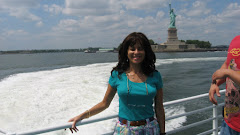
Here is an article describing how Easter Island’s indigenous population considers limiting visitors and immigrants to one of Chile's top tourist destinations.
SANTIAGO, Chile — They are the face of Chilean guidebooks: giant statues made of volcanic rock scattered across Easter Island.
Constructed centuries ago, the figures are thought to represent ancestors or chiefs of the indigenous Polynesian population. It is their descendants who now inhabit the tiny triangular island nearly 2,000 miles off the Chilean coast.
But they're fed up with the hundreds of immigrants who keep flooding the island in search of fortune. These immigrants, they say, are destroying the ecosystem, taking their jobs and ruining the historical legacy of their ancestors.
And so they're fighting back in the hope of restricting residence on the island, known in the indigenous tongue as Rapa Nui.
With more than 4,000 people — about half non-natives, mostly Chileans — living on 62 square miles, the islanders feel they are already overpopulated. Waste disposal is becoming a serious problem, as trash keeps piling up and the litter spreads in proportion to its population.
The situation has become particularly acute in recent years after the opening of large hotel complexes and increasingly more airline flights to the island. The island, unaccustomed to violent crimes or homicides, is now also attracting petty crime, theft and drugs.
“The underlying problem is that there are too many immigrants bringing with them bad habits, or are fugitives, drug addicts or delinquents looking for opportunities for crime. A year ago I would leave my house unlocked. I can’t do that anymore,” said Cecilia Rapu, a native Rapanui, in a phone interview from the island.
It is believed the island was colonized by Polynesean immigrants around A.D. 300. Centuries later, the island community started building altars and figures sculpted out of volcanic rock called moais, groups of which represented a particular tribe. The hundreds of moais, which weigh between 14 and 80 tons and the tallest of which stands at 5 meters, are the island’s main tourist attraction.
The island got its Westernized name when a Dutch explorer arrived there on Easter Sunday of 1722. Chile colonized the island in 1888, and subsequent European expeditions made the island famous for its exotic moais. Regular tourism began with the construction of the airport in the early 1980s, but the real boom started in the 1990s, and by now, the island receives about 50,000 tourists a year that come in daily flights and cruise ships.
Easter Island was declared a World Heritage site by UNESCO in 1995.
In August, in protest against the encroachment, islanders blocked the landing strip at the Mataveri airport. For 48 hours, the Rapanui proved they could halt their economy, which is almost completely pegged to the tourism industry.
The government sent in a delegation to negotiate their demands, and on Oct. 24, more than 96 percent of the native islanders voted in favor of a referendum for a constitutional amendment that would restrict residence on the island. Now, Congress must approve the change.
“People come here to make a fortune with tourism and compete under unequal conditions with the Rapanui," said Jose Letelier, a long-time resident on the island, who, like 80 percent of the islanders, makes his living in tourism.
He said government and military employees receive higher salaries than local workers. Because the mainlanders are working in a far-away zone, they get tax exemptions, free housing and free freight to bring their cars and goods. The Rapanui get none of these advantages and have to spend significant capital to ship any goods to the island, said Letelier, who is a Chilean from the mainland married to a Rapanui.
An architect, Letelier arrived in the early 1990s to participate in public works projects and witnessed the paving of the first street in Hanga Roa, the main settlement. Back then, he said, there were about 40 vehicles and 2,500 residents who all knew each other or were related in some way. By now, the population has nearly doubled and there are 50 times more vehicles.
The October referendum was the first time the Convention 169 of the International Labor Organization on indigenous peoples, in effect in Chile since September, has been applied here to consult a native population about decisions that affect them, as called for by the treaty.
Under the proposed amendment, the local government would be allowed to restrict residence or travel to the island if necessary to protect the environment. The wording of the bill doesn't specify whether restrictions apply to tourism or immigration, or both.
The 26 of the 706 islanders who voted against the reform claim the bill is too ambiguous.
“I voted against it out of fear, because the proposal is unclear. It doesn’t specify if it refers to immigrants or the native population. It just says that the government can decide how many people can live here and how many would have to leave, and that includes even us, the Rapanui,” Rapu said.
At stake, they say, are no less than their natural habitat and historical patrimony.
“So many tourists trampling around, touching the moais, stepping on them," said Raul Domenech, and anthropologist and research director of a recent documentary on Easter Island. "Companies come and film commercials with the moais. The island attracts archaeological tourism, not the sun-and-beach type of tourism.
"The day the first graffiti appears on a moai will be the beginning of the end.”
By Pascale Bonnefoy - GlobalPost
Published: November 6, 2009 06:42 ET
http://www.globalpost.com/dispatch/chile/091103/easter-island-tourism






.jpg)
.jpg)




No comments:
Post a Comment